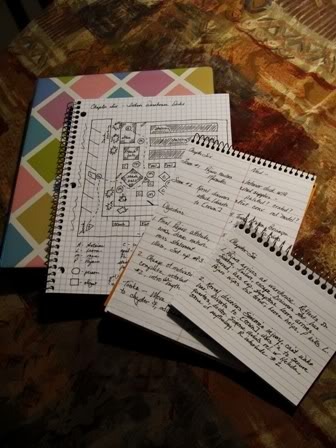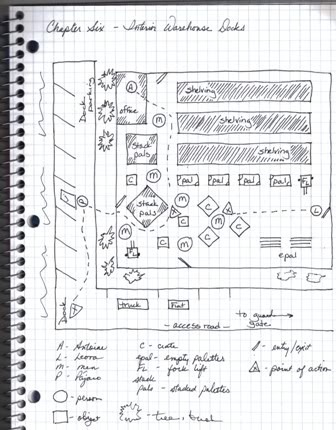No-Tech Note Solutions
 While I do love the convenience and efficiency of technology, as a writer I don't think I'll ever trust it. I am ruthless about backing up my work, which improves the odds of avoiding technology-created problems, but at least once a year I still lose something. No matter how careful I am, all it takes is one power outage during a work session and hours of work can go poof. And the problem isn't mine alone -- ask any writer, and I bet they have stories about files becoming corrupted, programs glitches sending a manuscript to NeverGetItBackLand and the ultimate horror, a complete hard drive melt down.
While I do love the convenience and efficiency of technology, as a writer I don't think I'll ever trust it. I am ruthless about backing up my work, which improves the odds of avoiding technology-created problems, but at least once a year I still lose something. No matter how careful I am, all it takes is one power outage during a work session and hours of work can go poof. And the problem isn't mine alone -- ask any writer, and I bet they have stories about files becoming corrupted, programs glitches sending a manuscript to NeverGetItBackLand and the ultimate horror, a complete hard drive melt down.The rapid advancement of technology also has another, built-in problem for writers who have been in the game for longer than a few years: it renders older technology obsolete and unusable, and by extension, anything you used them to create. Sure, I have multiple copies of every book I've ever written backed up and saved. About a fourth of those backups are now unusable because my current writing software can't convert the old file formats from the programs I used in the past. If ever decided to reprint my old Gena Hale romances, for example, I'd have to either retype the manuscripts or scan each page from my old hard copies and digitally convert them.
There are all kinds of new tech solutions to old tech problems, but sometimes technology simply interferes too much with my writing process for me to use it. Like note-taking. I could keep notes on the computer in some form or another and multi-task between documents or programs while writing. The thing is, I don't like jumping from one window to another when I'm writing; it destroys my rhythm and my momentum. I also like to be able to look at my story notes while I'm actively writing. This is why I still keep my notes in some hard copy form on my work station. I also like playing with office supplies, so over the years I've come up with some interesting, no-tech ways to manage the notes I use while writing:
 Chapter Summary Deck
Chapter Summary DeckI admit, I've never been a huge fan of index cards. Because they're loose they're easy to shuffle out of order or misplace; they're really too small to contain much info, the only way to hold them together was by rubberbanding them, and a stack is usually too bulky to comfortable stow in the binder pocket of my novel notebook.
After years of working straight from a printed copy of a synopsis, I started experimenting with ways to break down a novel into brief chapter summaries. I tried small notepads, sticky notes and then decided to look at index cards again. That was when I discovered spiral-bound index cards. While the lines are still too narrow, binding the index cards into a deck solved all the other problems I had with them. When I'm finished, I simply hook the deck's spiral binding through the top clip of my novel notebook binder, which keeps it neatly in place.
Now I'm constantly finding new ways to use spiral-bound index cards: as character stat indexes, series mini-encyclopedias (when you invent an entire new universe, just trying to keep tracking of the names of all the different worlds can be a real headache), personal style Bibles and more.
 Steno Noting
Steno NotingWhen I was a kid I never had enough paper to write on, and since new paper was too expensive to constantly buy, my mom got me into recycling used paper long before it was fashionable. My favorite recycled paper to use was the back of the pages in one of Mom's old steno pads. Instead of throwing them away when they were used up, she would bring them home from work and give them to me. Because she only wrote on one side of the pages, I'd just flip the book over and write my poems on the blank sides. I loved that red line running down the center of the page because I'd write my poem on the left side of the line and then use the right side to jot down alternative words and phrase ideas when I edited the poem.
I still use steno pads, which I buy new by the dozen from the local dollar store. Those two-column pages are great for writing everything from pro and con lists to character comparisons. When I'm working on a novel, I jot down my chapter objectives on the left side and while I'm writing make notes about things I need to find out, check in my research notes or otherwise redo during my daily editing session.
Steno pads also serve as excellent checklists (put your items on one side, and check off or date when you complete them on the other); daily quota tally sheets (list your dates and daily totals on the left and your running monthly total on the right) and even a simple planner for your week (days of the week on the left, lists of what you plan to do each day on the right.) Steno pads are also wonderful for compiling lists of title ideas, because you can run a column of ideas down one side and then jot some variations of the idea beside them.
 Graph Paper Mapping
Graph Paper MappingMany writers are insanely talented map makers and floor-plan creators, and a few rank right up there with professional cartographers and architects. Sadly, I am not one of these gifted folks. Using freehand, I couldn't map my way out of a 5X5 square cardboard box. Whenever I desperately needed to lay out a fictional location or make up a floor plan so I could choreograph a scene, I had to rely on what was in my head, or draw something that looked like driving directions an inebriated dyslexic had penned in complete darkness in felt-tip on a cocktail napkin.
Graph paper finally came to my rescue (via my quilting, no less.) Whenever I design a pattern for a patchwork quilt, I use graph paper because the little squares help keep my lines straight, and are easy to count when I'm trying to figure out proportions. After screwing up yet another hand-drawn blue print of a fictional location, in frustration I pulled out a graph paper pad to work on a quilt pattern design. At last the light bulb went on and I tried drawing my floor plan again, this time thinking about the design the same way I did a quilt block and using the squares on the graph paper as a line guide and an area mapper. Worked fabulously for me, and now I use graph paper for everything I map out.
Have you come up with any no-tech and/or non-tradition ways to manage your notes? Share your tips in comments.
Published on April 05, 2011 21:00
No comments have been added yet.
S.L. Viehl's Blog
- S.L. Viehl's profile
- 224 followers
S.L. Viehl isn't a Goodreads Author
(yet),
but they
do have a blog,
so here are some recent posts imported from
their feed.



